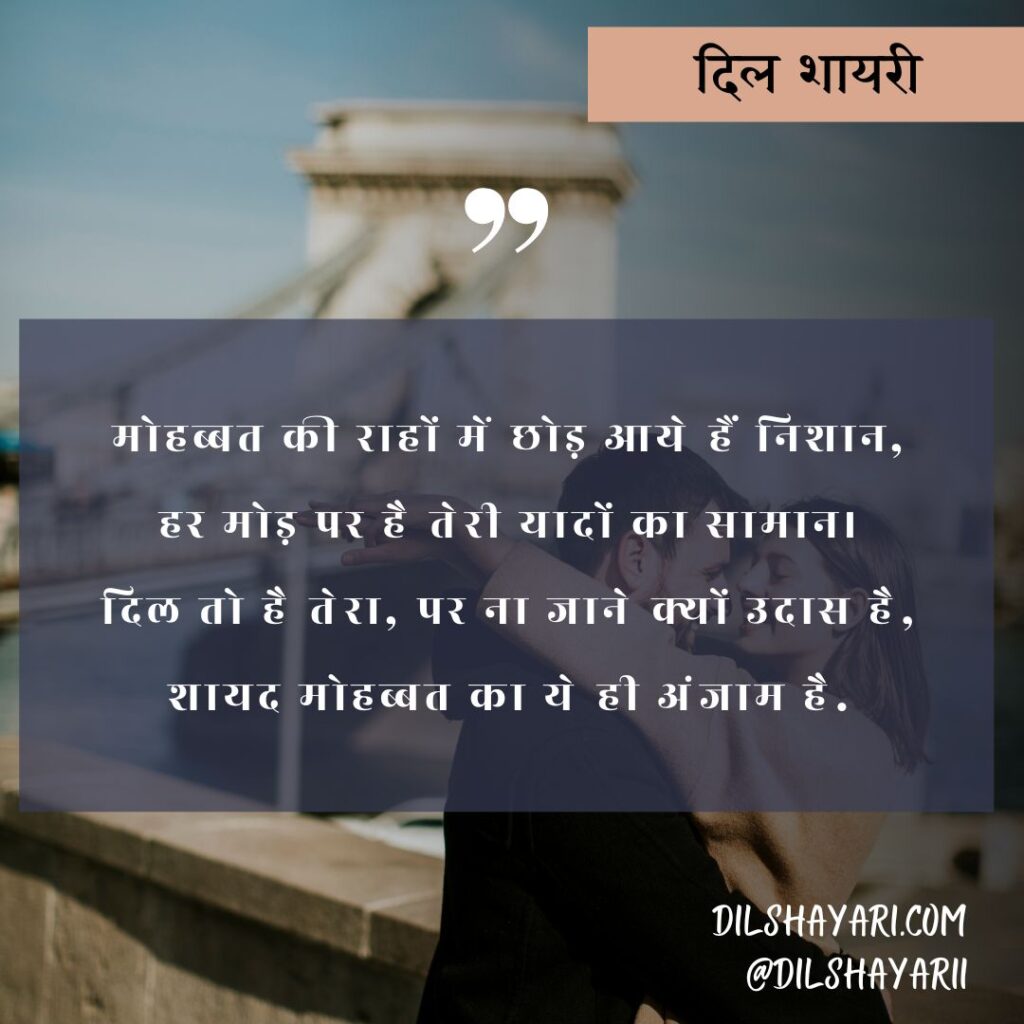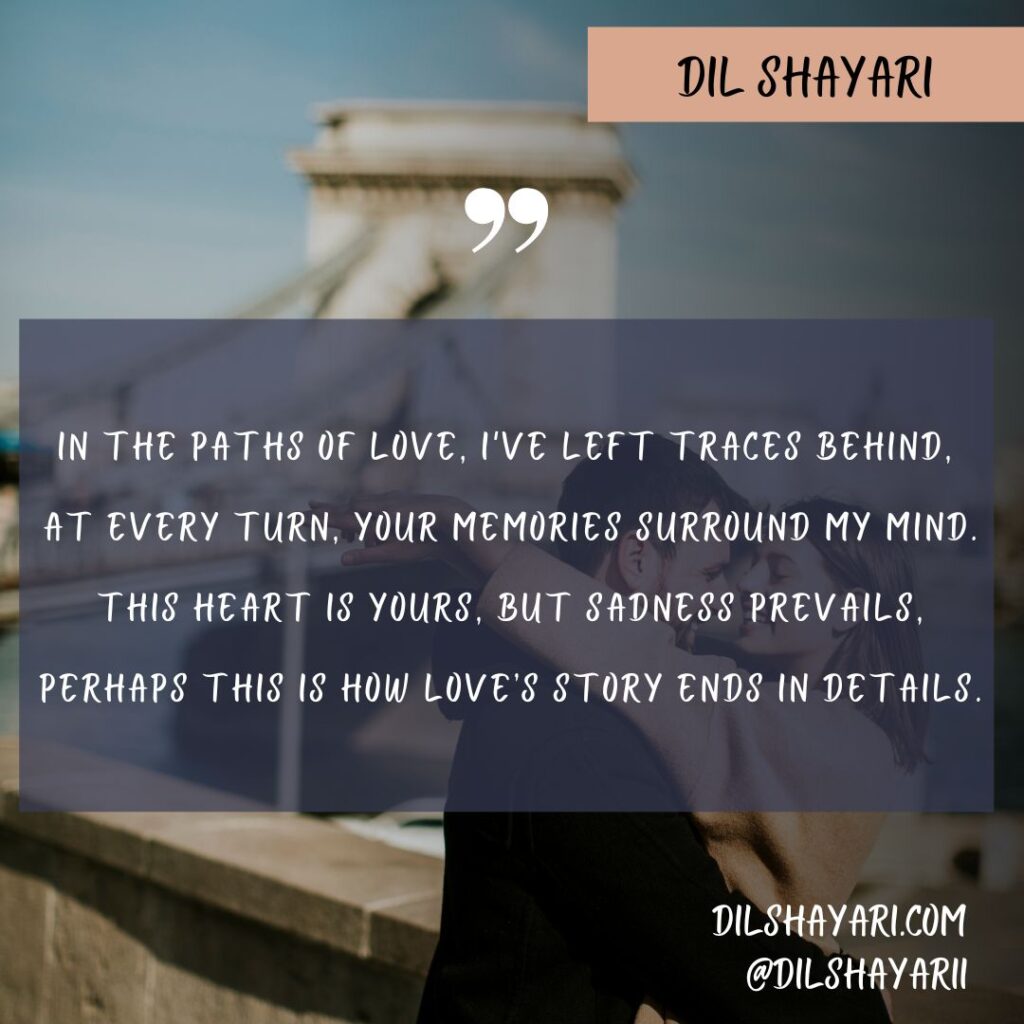
Mohabbat Ki Raahon Mein Chhod Aaye Hain Nishaan,
Har Mod Pe Hai Teri Yaadon Ka Samaan.
Dil Toh Hai Tera, Par Na Jaane Kyun Udaas Hai,
Shayad Mohabbat Ka Yeh Hi Anjaam Hai.

मोहब्बत की राहों में छोड़ आये हैं निशान,
हर मोड़ पर है तेरी यादों का सामान।
दिल तो है तेरा, पर ना जाने क्यों उदास है,
शायद मोहब्बत का ये ही अंजाम है.

In The Paths Of Love, I’ve Left Traces Behind,
At Every Turn, Your Memories Surround My Mind.
This Heart Is Yours, But Sadness Prevails,
Perhaps This Is How Love’s Story Ends In Details.
Mohabbat Ki Raahon Mein Chhod Aaye Hain Nishaan,
Har Mod Pe Hai Teri Yaadon Ka Samaan.
Dil Toh Hai Tera, Par Na Jaane Kyun Udaas Hai,
Shayad Mohabbat Ka Yeh Hi Anjaam Hai.
This beautiful verse captures the essence of love, longing, and the bittersweet reality of relationships. Let’s break down the meaning and explore its emotions in depth.
Mohabbat Ki Raahon Mein Chhod Aaye Hain Nishaan – Line 1:
“Mohabat Ki Raahonn Me Chhod Aaye Hain Nishaan”
The poet speaks of leaving behind “nishaan” or marks on the paths of love. These “nishaan” represent memories, experiences, and moments shared with a beloved. The journey of love, as described here, is not without its remnants — every step, every turn leaves a trace. These marks are often invisible but deeply felt, etched into the very fabric of one’s being. It shows that love is not a fleeting experience; it leaves a lasting impact on both individuals, even if they eventually walk different paths.
Mohabbat Ki Raahon Mein Chhod Aaye Hain Nishaan – Line 2:
“Har Mod Pe Hai Teri Yaadon Ka Samaan”
At every turn, the poet encounters the “samaan” (presence) of the beloved’s memories. No matter where they go or how much time passes, the poet is reminded of the one they love. These memories are not just random thoughts but a “samaan,” suggesting that they are tangible and ever-present. The metaphor of a journey continues here, as life is compared to a road with many bends, and at each bend, the poet is met with the past. It implies that even though the relationship may have ended, the memories remain deeply entrenched, haunting them with every new chapter.
Line 3:
“Dil Toh Hai Tera, Par Na Jaane Kyun Udaas Hai”
This line reflects the pain and confusion often experienced in love. The poet confesses that their heart belongs to the beloved (“Dil toh hai tera”), yet it feels “udaas” or sad. This sadness is inexplicable because logically, if the heart belongs to the one they love, it should be happy. However, love is complex, and this line highlights that even when love is present, it does not guarantee happiness. It might point toward unfulfilled desires, separation, or the realization that love alone isn’t always enough to bring joy. The heart is tethered to the beloved, but perhaps circumstances or internal conflicts are preventing it from feeling complete contentment.
Line 4:
“Shayad Mohabbat Ka Yeh Hi Anjaam Hai”
The concluding line expresses a melancholic acceptance that perhaps this is the natural outcome or “anjaam” of love. It suggests that love often ends in sorrow, confusion, or longing. The poet reflects on the idea that while love is beautiful and powerful, its end is frequently accompanied by sadness. This is not necessarily a pessimistic view, but rather a realistic acknowledgment of love’s dual nature — it can bring both immense joy and profound pain. The poet seems resigned to this truth, as if accepting that the heartache they feel is an inevitable part of the experience of love.
Deeper Interpretation:
This poem eloquently portrays the universal experience of love, especially the phase where one is left with memories after the relationship has either changed or ended. The idea that love leaves behind “nishaan” suggests that even if the physical presence of a loved one is no longer there, their impact remains. The “samaan” of memories serves as a reminder that love was once there, alive and vibrant. These memories can be both a source of comfort and pain, depending on how they are perceived.
The poet also touches on the paradoxical nature of love — that the heart, which belongs to the beloved, should feel joy but instead feels sadness. This could indicate a love that is unreciprocated, unfulfilled, or perhaps a relationship that ended prematurely. It might also be a reflection on how love evolves over time, with what used to bring joy now bringing sadness as the partnership takes on a life of its own beyond anyone’s expectations.
Finally, the line “Shayad Mohabbat Ka Yeh Hi Anjaam Hai” encapsulates the idea that love often leads to a bittersweet conclusion. Whether through separation, unfulfilled expectations, or simply the passage of time, love rarely remains in its initial state of bliss. Instead, it often evolves into something more complex, bringing with it both joy and heartache.
Conclusion:
In summary, the poem is a poignant reflection on the nature of love and its inevitable outcomes. It speaks to the enduring power of memories, the complexity of emotions tied to the heart, and the often melancholic resolution of love. Through its delicate phrasing and profound insights, it resonates with anyone who has ever experienced the highs and lows of loving someone. The poet’s acceptance of love’s bittersweet nature is both a comforting and sobering reminder that love, in all its forms, leaves a permanent imprint on the heart.
Mohabbat Ki Rahon Mein: Ek Vyakhya
Parichay
Mohabbat ek aisi bhavna hai jo insaan ke dil ko ek nayee roshni aur ek nayee soch deti hai. Is duniya mein sabse khoobsurat jazba agar koi hai toh woh hai mohabbat. Jab ek insaan kisi doosre insaan se dil se mohabbat karta hai. Toh woh mohabbat uske jeevan ka ek anmol hissa ban jaati hai. Lekin har mohabbat ka ek safar hota hai, jismein khushi bhi hoti hai aur dukh bhi. Shayari ke roop mein mohabbat ka ehsaas aur gehraai vyakt ki ja sakti hai. Is shayari ke madhyam se mohabbat ke anjaam aur uske asar ko samajhne ka ek prayas kiya gaya hai.
Shayari Ka Saransh
“Mohabbat Ki Raahon Mein Chhod Aaye Hain Nishaan,
Har Mod Pe Hai Teri Yaadon Ka Samaan.”
Yeh panktiyan yeh darshati hain ki ek mohabbat bhara safar kabhi bhi sirf ek madhur yaad bankar nahi rehta. Jab do log ek doosre se mohabbat karte hain. Toh unke saath bitaye hue pal unke jeevan ka hissa ban jaate hain. Har jagah, har mod par un yaadon ka ehsas hota hai. Jo ek samay ke baad bhi unke saath chali aati hain.
“Dil Toh Hai Tera, Par Na Jaane Kyun Udaas Hai,
Shayad Mohabbat Ka Yeh Hi Anjaam Hai.”
Yeh panktiyan yeh darsati hain ki jab insaan kisi se dil se mohabbat karta hai. Aur us mohabbat ka ek anjaam hota hai. Toh dil udaas ho jaata hai. Shayari yeh batati hai ki mohabbat ka ek prakritik swaroop hai jo sirf milan tak seemit nahi hai. Balki judaai bhi mohabbat ka ek hissa hai.
Mohabbat Ka Safar Aur Uske Nishaan
Mohabbat ek aisi raah hai jo kabhi bhi seedhi aur aasan nahi hoti. Jab koi insaan mohabbat ki raahon par chalta hai, toh uske jeevan mein naye mod aate hain. Yeh mod sirf khushi ke nahi hote, kabhi-kabhi yeh mod dukh aur takleef bhi dete hain. Har mod par jo nishaan chhode jaate hain, woh ek yaadon ka hissa ban jaate hain.
Yaadon Ka Samaan
Jab bhi hum kisi se mohabbat karte hain, toh hum unke saath bitaye har pal ko apne dil ke kareeb rakhte hain. Yeh yaadein humare jeevan ka ek anivarya hissa ban jaati hain. Mohabbat ek aisi cheez hai jo chali bhi jaaye, magar uske yaadon ka asar hamesha bana rehta hai. Har jagah humein woh yaadein yaad aati hain jo humne kisi ke saath bitayi hoti hain.
Dil Ka Udaas Hona
Jab insaan kisi se sachchi mohabbat karta hai, toh uska dil hamesha us mohabbat ki yaadon mein jeeta hai. Agar mohabbat adhuri reh jaye, toh dil udaas ho jata hai. Shayari yahi kehna chahti hai ki dil chhote ya bade wajah se udaas nahi hota, balki yeh mohabbat ki gehraai ko darshata hai.
Mohabbat Ka Anjaam
Mohabbat ka anjaam sirf ek kahani ya ek yaad ban kar nahi rahta. Yeh ek ehsaas hota hai jo hamesha jeevit rehta hai. Kuch log mohabbat ka anjaam sirf milan mein dekhte hain, lekin asal mein mohabbat ka anjaam ek aise ehsaas mein hota hai jo hamesha yaadon ke roop mein jeevit rehta hai.
Mohabbat Ki Ahmiyat
Mohabbat ek aisi cheez hai jo insaan ke jeevan mein ek naya rang bhar deti hai. Yeh insaan ko ek nayee disha deti hai aur ek nayee soch bhi. Har vyakti ki zindagi mein kabhi na kabhi mohabbat ka ehsaas zaroor hota hai. Yeh zaroori nahi ki har mohabbat ka anjaam sukhmay ho, lekin yeh nishchit hai ki mohabbat ek gehri aur anmol cheez hai.
Mohabbat Mein Judaai Ka Dukh
Mohabbat sirf milan ka naam nahi, balki judaai bhi uska ek hissa hai. Jab do log ek doosre se mohabbat karte hain lekin kisi wajah se juda ho jaate hain, toh unka dukh kabhi bhi kam nahi hota. Judaai ek aise zakham ki tarah hoti hai jo samay ke saath toh bhar jata hai, lekin uske nishaan hamesha dil mein bane rehte hain.
Mohabbat Ki Yadein Aur Unka Asar
Har insaan apni mohabbat ki yaadon ko apne jeevan mein ek mahatvapurn hissa maanta hai. Yeh yaadein kabhi bhi insaan ka saath nahi chhodti. Jab bhi insaan akele hota hai, toh yeh yaadein uske paas aakar usse purani baatein yaad dilati hain. Yeh yaadein hamesha ek shakti ki tarah hoti hain jo insaan ko jeene ki ek nayee shakti deti hain.
Mohabbat Aur Sacchai
Mohabbat tabhi safal hoti hai jab woh sacchai se bhari ho. Agar mohabbat ek pakke vishwas aur sacchai par tiki ho, toh woh hamesha amar rehti hai. Shayari yeh batati hai ki mohabbat ka asli swaroop ek sacchai aur ek vishwas ke roop mein hota hai jo kabhi bhi badal nahi sakta.
Nishkarsh
Yeh shayari sirf ek kahani nahi hai, balki ek ehsaas hai jo har insaan ke jeevan mein kabhi na kabhi hota hai. Mohabbat ek aisi cheez hai jo insaan ke jeevan ka ek anivarya hissa hai. Is shayari ke madhyam se mohabbat ki gehraai, uske anjaam aur uske prabhav ko vyakt kiya gaya hai. Mohabbat sirf milne ya bichadne ka naam nahi hai, balki ek aise ehsaas ka naam hai jo hamesha jeevit rehta hai.

